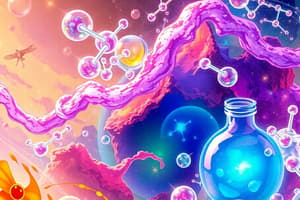Podcast
Questions and Answers
How can matter be classified?
How can matter be classified?
Matter can be classified into groups based on what makes up the matter.
Why are carbon and copper classified as elements?
Why are carbon and copper classified as elements?
Every element is made up of a single kind of atom.
How are elements related to compounds?
How are elements related to compounds?
Elements cannot be broken down into simpler substances and when they mix chemically, they create compounds.
What is the difference between a pure substance and a mixture?
What is the difference between a pure substance and a mixture?
What is the relationship between atoms and elements?
What is the relationship between atoms and elements?
What are examples of pure substances?
What are examples of pure substances?
What is the comparison between mixtures and substances?
What is the comparison between mixtures and substances?
How can matter be classified?
How can matter be classified?
Can elements be broken down into simpler substances?
Can elements be broken down into simpler substances?
How are elements represented?
How are elements represented?
How many types of atoms is an element made out of?
How many types of atoms is an element made out of?
All solutions are mixtures. (True/False)
All solutions are mixtures. (True/False)
Water molecule is an example of what type of substance?
Water molecule is an example of what type of substance?
Can gases be broken down into simpler substances?
Can gases be broken down into simpler substances?
Can gases mix with liquids?
Can gases mix with liquids?
What is the difference between the two types of mixtures?
What is the difference between the two types of mixtures?
Flashcards are hidden until you start studying
Study Notes
Classification of Matter
- Matter can be classified into groups based on composition, including elements, compounds, and mixtures.
- Elements consist of a single type of atom and cannot be broken down into simpler substances.
Elements vs. Compounds
- Carbon and copper are classified as elements because they consist only of their respective atoms.
- When elements chemically combine, they form compounds that have different properties than the individual elements.
Pure Substances vs. Mixtures
- A pure substance is made solely of one type of element or a specific compound, while mixtures contain non-bonded substances combined.
- Examples of pure substances include carbon, iron, water, sugar, salt, nitrogen gas, and oxygen gas.
Relationship Between Atoms and Elements
- Each element corresponds to a specific type of atom, and all elements are composed of atoms.
- Atoms define the unique characteristics of each element.
Mixtures and Solutions
- Mixtures can be classified into two types: homogeneous (evenly mixed) and heterogeneous (not evenly mixed).
- Solutions are specific types of mixtures where one substance is dissolved in another, such as sugar in water.
Physical States and Interactions
- Gases can mix with liquids, demonstrating the flexibility of matter's states and interactions.
- Water molecules serve as an example of a pure substance, emphasizing the concept of purity in substances.
Element Breakdown
- A key characteristic of elements is that they cannot be broken down into simpler substances, making them fundamental in the study of chemistry.
Representation of Elements
- Each element is represented by a symbol, allowing for standardized communication about different kinds of matter.
Studying That Suits You
Use AI to generate personalized quizzes and flashcards to suit your learning preferences.




